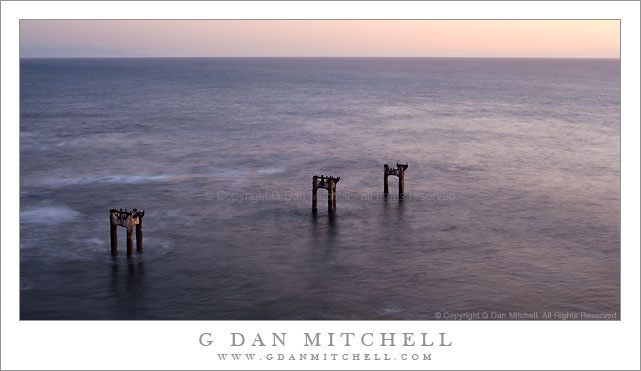Abandoned Pier, Davenport, Dusk. Pacific Coast between Santa Cruz and San Francisco, California. November 28, 2010. © Copyright 2010 G Dan Mitchell – all rights reserved.
Twilight on the pilings from the old abandoned pier along the California shoreline near Davenport.
This photograph of this scene was made a bit earlier than the companion photograph that I posted yesterday – here there is a much warmer tone to the light since it is only shortly after sunset. (For those who didn’t see yesterdays long post, these old pilings used to support a pier near the town of Davenport, along the California coast just north of Santa Cruz.)
This photograph was made with a slightly long exposure time of six seconds, with the idea obviously being to allow wave motion to smooth out the texture of the water’s surface. A six-second exposure is not nearly long enough to really smooth out the features of the water, and you can still see localized lower and higher areas from the incoming waves. Interestingly, the birds on the tops of the structures – barely visible here but clearly visible in larger versions – barely move at all after sunset. You might not even notice the movement in this exposure and even in the three-minute exposure that I made a bit later the birds are mostly still!
Although I rarely do so, in this photograph I stopped down all the way to f/22. The concern with that aperture on a full frame DSLR is that some visible diffraction blur may begin to appear. Indeed, if I inspect this photograph at 100% magnification, there is a slight softening of fine detail – just as I knew there would be. I chose to use the longer aperture because it allowed me to double the exposure time without using neutral density filters, and I was willing to do so here because absolute sharpness is much less important to this image than it might be in other cases.
G Dan Mitchell Photography
About | Flickr | Twitter | Facebook | Google+ | 500px.com | LinkedIn | Email
Text, photographs, and other media are © Copyright G Dan Mitchell (or others when indicated) and are not in the public domain and may not be used on websites, blogs, or in other media without advance permission from G Dan Mitchell.
(Basic EXIF data may be available by “mousing over” large images in posts. Leave a comment if you want to know more.)
Discover more from G Dan Mitchell Photography
Subscribe to get the latest posts sent to your email.


Thanks for the compliment, Robert. While panorama format photographs form a distinct minority of my work, I have real fondness for the very wide formats. Among my favorite photographs is one I made a few years ago of a grove of winter oak trees, and I cannot imagine a better format for that shot.
Dan
Great work as usual Dan.
I occasionally shoot in the 6×12 format, but I generally previsualize the shot first The panoramic format can be quite enjoyable, if done right; as this one was.
This was my suspicion Dan, I’ve noticed this ratio before in your work and thought it was interesting so I figured you might just be on another plain of pre-visualization than me.
As it turns out I work in essentially the same way. I hardly ever pre-visualize in a Panorama ratio but instead mostly see compositions in 4:5. In fact even when I considered most of my photos finished in a 3:2 negative format I found when I went back most of my old photos worked better in 4×5, I think I stayed up until 3am furiously cropping photos the day I realized that.
Yes. It is. :-)
In this case, my primary “pre-visualization” was as a 3:4 ratio image – in other words, my initial thought was that I’d lose the far edges of the frame from my full frame DLSR image. The first photograph I posted from this shoot (posted here) uses essentially the format I was thinking of. By the way, that image is also the very last shot I made – which didn’t surprise me since I wanted the longest exposure possible and I wanted to work with post-sunset fading light.
However, I also look at photographs in “post” and often find things in some of the photographs that I didn’t fully understand at the time I made the exposure. This shouldn’t be too surprising since we are often working quickly or working in light – as in these shots – where it is difficult to truly see the scene as it will appear in a print.
In my experience, despite some assumptions and protestations to the contrary, quite a few photographers work this way. In other words, we often have an initial concept of how the photograph will look and we quite often end up going “that direction,” but we also recognize that if we find a better way to “see” the image in post that it is fine to be flexible.
I prefer the 4:3 ratio most of the time. I’m not so fond of the native 3:2 ratio of 35mm film and DSLRs, though sometimes it works well. Occasionally I go for the “classic” 4:5 ratio with some scenes. This photograph uses a 2:1 ratio, which is sort of my “default” panorama format. Nearly everything I do ends up in one of those formats. On rare occasions I create a photograph using a square format, and I have also done some very wide stitched panoramas in which the width is more than twice the height.
It is complicated! :-)
Dan
I’m always curious when I see other photographers use unique ratio’s for their photographs if that was something you visualized before you took the photo or if you found that using something other than 4×5 worked best in post-production.